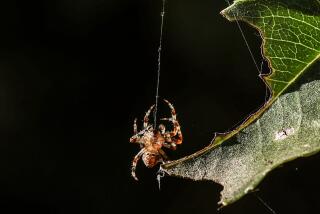Swat Team : Officials Take Bite Out of Insect Boom Spawned by Rains
Heard the buzz? Heavy rains that helped end the nuisance of water rationing have spawned another pesky problem in Los Angeles County--a mosquito population boom.
The Southeast Mosquito Abatement District, the countyâs largest, trapped 998 mosquitoes during March--up from 240 during the same period a year ago.
The agency--which serves an area from the Orange County border to Castaic, including most of central Los Angeles and the San Fernando Valley--also reported receiving 27 complaints about mosquitoes in March, compared to none last March.
Bite complaints to the countyâs other major mosquito-fighting agency, the West Mosquito Abatement District, were even more plentiful, totaling 156 last month--10 times the number for the same period last year.
âWeâve had other years where theyâve been high, but never this high,â said Robert Saviskas, executive director of the West district.
And the worst may be yet to come. Mosquito season--yes, there really is such a thing--does not begin officially until May.
But mosquito control officials, gearing up for a bad year, have stepped up efforts to detect the insects and to eliminate the standing water that serves as breeding grounds for the 11 varieties of mosquitoes found in the county.
In one novel tactic, officials have sent speakers into elementary schools to recruit âofficial mosquito busters.â The children, equipped with badges depicting a red slash through a mosquito, are sent into their back yards to dump standing water from containers such as birdbaths, buckets and tires.
Such efforts can yield big results. âA bucket of water can produce thousands of mosquitoes in a very short period of time,â said Saviskas, whose agency stretches from the South Bay to Malibu.
The agencies also are planning to launch aerial patrols in which helicopters will look for green, algae-filled swimming pools, another favorite haunt for breeding mosquitoes. The insects cannot breed in properly maintained, chlorinated swimming pools.
Meanwhile, health officials are on alert for an outbreak of St. Louis encephalitis, a mosquito-borne disease that can be transmitted to humans.
So far, no signs of the disease have been detected in humans this year. However, the discovery in February of the virus in chickens in Long Beach âput us on our guardsâ for a potentially bad mosquito season, said Frank Hall, chief of vector-borne disease surveillance and entomology for the county Department of Health Services.
St. Louis encephalitis, commonly called sleeping sickness, can cause headaches, flu-like symptoms and, in extreme cases, coma and death.
The worst year for St. Louis encephalitis in the county in recent years was in 1984. Sixteen people came down with the disease in Los Angeles County, and one died. Last year, one nonfatal case was reported in the county.
Mosquitoes also can carry malaria, but health officials say there has been no case of locally acquired malaria since the 1940s.
Officials said the mosquito boom is exacerbated by the timing of recent rains. âThe greater the rain late in the season, the greater the problems we have with mosquitoes,â said Saviskas. Early rainfall has less impact because it comes before the weather is warm enough to foster breeding.
âWeâll probably see this as the highest late season rain weâve had in some time,â Saviskas said.
Residents also may be noticing swarms of other bugs, such as midges, fungus gnats and the big crane fly, whose populations have also been increased by the rains. These insects do not bite but can be a nuisance.
No matter how bad the problem gets, there are no plans to resort to the controversial Medfly-fighting technique of aerial pesticide spraying.
While such spraying is used in mosquito-infested Florida, officials here rely on natural predators to kill mosquitoes. The districts make available free, tiny, mosquito-eating fish that can be placed in swimming pools and decorative fountains.
But primarily, officials encourage people to drain standing water. To reinforce that message, the districts respond to complaints from neighbors by sending out swat teams--inspectors who seek likely breeding centers.
Those who fail to comply can be stung by fines.
Mosquito Season Arrives Early Recent rains have left behind puddles where mosquitoes can breed. Within the span of a week, thousands of new ones can emerge from sources of standing water as small as a bucket. The pests breed year-round, but spring rains lead to peak activity in summer. 1) Eggs Laid (Days 1 and 2) The female mosquito lays 100 to 400 eggs, which hatch into larvae. Local species can lay up to 1,000 eggs in a lifetime. 2) Larvae Grow (Days 3 and 4) Larvae breathe through tubes while remaining below the waterâs surface. Long, hairy âmouth brushesâ help them sweep up and eat tiny plants and animals. 3) Metamorphosis (Days 5 and 6) A grown larva changes into a pupa, where skin covers a rapidly changing adult. Mature adult emerges after about two days. 4) Adult Mosquito (Day 7) The adult rests until strong enough to fly. Females live up to three weeks in summer and maybe for months in winter, in order to lay eggs in the spring. Males live 10 to 20 days. How a Mosquito Bites Only female mosquitoes âbite,â a misnomer since they actually pierce the skin. Blood provides protein for the femaleâs eggs, which she cannot get by sipping plant nectar. Skin Pierced: Mosquito pushes several needle-like âstyletsâ through the skin and into a blood vessel. Saliva flows into the bite to prevent clotting. Saliva of some mosquito species will cause an itchy welt. Blood Drawn: Mosquito sips up to 1 1/2 times her weight in blood. Abdomen swells with blood. She leaves behind a droplet from intestines to reduce her weight before flying away.Source: Orange County Vector Control; World Book Encyclopedia Researched by DANNY SULLIVAN/Los Angeles Times
More to Read
Sign up for Essential California
The most important California stories and recommendations in your inbox every morning.
You may occasionally receive promotional content from the Los Angeles Times.











